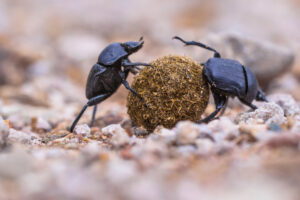
I became intrigued by dung beetles several years ago when I began to notice a couple of species of dung beetles in my yard making good use of the dung left behind by our dogs! As I began reading and learning more about these amazing beetles, I ran across some fascinating research being done on dung beetles in rainforest habitats.
The research indicates that a mutualism exists between three species—howler monkeys, dung beetles and fruit trees. Here is how the relationship unfolds. Howler monkeys spend lots of time in the fruit trees of the tropics eating the fruit and foliage. They deposit the seeds of the trees mixed with their dung below the trees. Left there, the seeds would be concentrated too densely to germinate and successfully produce very many trees. That is, the saplings would be in competition with each other for nutrition and sunlight. The seeds would also be vulnerable to rodents who would use them for food. These factors would all work together to reduce the population of fruit trees.
Enter the dung beetle—an unlikely hero. The dung beetle gathers up the dung, which happens to be mixed with seeds, from the piles in balls and roles them away. The female lays her eggs in the ball of dung or “brood ball” and the male and female then bury the brood balls a few inches below the ground surface. Because of the presence of dung beetles, the seeds of the trees are dispersed more widely and are buried at a depth that protects them from rodents. More of the seeds germinate and, ultimately, the howler monkeys benefit from the work of the beetles! If something threatens any of the three populations, the other two will also be threatened.
This is but one of many such examples of interdependence between various species. Understanding these relationships helps us understand the fragile balance of our world…and the potential cascade of extinction that can occur when one species is threatened.
We humans are an integral part of this landscape of complex interdependence. Seeing ourselves as independent of or separate from the ecosystems around us creates a false dichotomy. The sooner we can erase this imaginary line and embrace our intimate connection with the rest of the natural world the better—for our individual and collective well-being, and for the planet as a whole.
The further human society drifts away from nature, the less we understand interdependence.
Peter Senge
The Creator, if He exists, has an inordinate fondness for beetles.
JBS Haldane (in response to an inquiry regarding what his studies of nature had taught him about God)
Sources:
- Andresen, E. (2002). Primary seed dispersal by red howler monkeys and the effect of defecation patterns on the fate of dispersed seeds. Biotropica, 34 (2), 261-272.
- Estrada, A. and Coates-Estrada, R. (1991). Howler monkeys (Alouatta palliata), dung beetles (Scarabaeidae) and seed dispersal: ecological interactions in the tropical rain forest of Los Tuxlas, Mexico. Journal of Tropical Ecology, 7, 459-474.